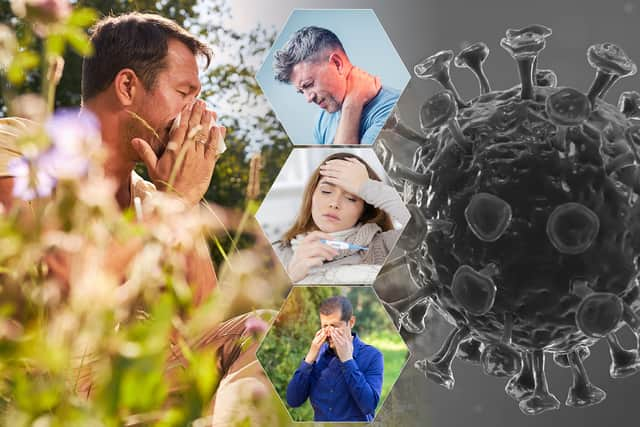Covid or hay fever? Key symptom differences after Omicron BA4 and BA5 variants drive UK infections
and live on Freeview channel 276
Covid is becoming more prevalent across the UK again as infections continue to rise across all four nations, new figures show.
A total of 1.7 million people are estimated to have had the virus last week, up 23% from 1.4 million a week earlier, according to the Office for National Statistics (ONS).
Advertisement
Hide AdAdvertisement
Hide AdThe rise is thought to have been driven by the newer BA.4 and BA.5 Omicron variants, which are now thought to be the most dominant strains in much of the UK.
The varaints were recently classified by the UK Health Security Agency as “variants of concern” and have been found to have a “growth advantage” over the BA.2 strain.
Initial findings suggest that BA.4 and BA.5 have a degree of “immunity escape”, meaning the immune system can no longer recognise or fight a virus, which is likely to contribute to their growth advantage over BA.4, according to the UK Health Security Agency (UKHSA).
Covid outbreaks in care homes have also jumped for the third week in a row, while hospital numbers are continuing to increase.


Advertisement
Hide AdAdvertisement
Hide AdThe spike in infections comes amid warnings of a “pollen bomb” across the UK, with the Met Office warning of high pollen levels.
Hay fever symptoms usually occur when the pollen count (the number of pollen grains in one cubic metre of air) exceeds 50 and are typically worse in the early evening when the count is at its highest.
If you have been suffering with sneezing, itchy eyes and a runny nose, and are unsure if the symptoms are hay fever or Covid, here’s a run down of the key differences to spot.
How can I tell the difference between Covid and hay fever?
The ZOE Covid Study has identified five symptoms that are most frequently reported by people who have tested positive for the virus. These include:
- runny nose
- fatigue
- sore throat
- headache
- sneezing
Advertisement
Hide AdAdvertisement
Hide AdHowever, these symptoms are all also common of hay fever, making it hard to tell the difference between the two.
But there are some noticeable differences in symptoms that can help tell the two apart, with a fever being the most obvious.
Hay fever does not usually cause a fever, so if you are suffering from a high temperature or shivers and chills, it is more likely that you are ill with coronavirus.
Similarly, a persistent cough, joint pains and muscle aches are also much more common of Covid than hay fever.
Advertisement
Hide AdAdvertisement
Hide AdThe main symptoms of hay fever, that do not typically overlap with Covid, include:
- itchy, red or watery eyes
- itchy throat, mouth, nose and ears
- earache
Marc Donovan, chief pharmacist at Boots, released a statement in April explaining the how to spot the difference between Covid and hay fever.
He advised: “Typical hay fever symptoms include sneezing, a runny or blocked nose, itchy red watery eyes or an itchy throat, mouth, nose and ears.
“The most common symptoms of Covid include a high temperature and/or a new continuous cough.”
Advertisement
Hide AdAdvertisement
Hide AdHe added: “It’s rare to have itchy, watery eyes or an itchy throat [with Covid], and hay fever doesn’t cause a high temperature.”
Why is hay fever so bad right now?
It has been suggested that hay fever is worse this year due to the warm weather this spring, which has made pollen much more potent.
Yolanda Clewlow, Met Office relationship manager for health and air quality, told the Weather Snap podcast: “In terms of the numbers of pollen grains in the air, what we’re seeing isn’t especially noteworthy compared to what we’ve had in previous years.
“However, the potency of these pollen grains could be more intense this year, and that comes down to the weather we’ve had in spring.
Advertisement
Hide AdAdvertisement
Hide Ad“A warm and wet May, coupled with a relatively warm spring, means there’s a chance that the pollen that has developed is particularly potent, even if the amounts aren’t dramatically different.”
While there is currently no cure for hay fever, it is possible to relieve symptoms with some simple treatments and home remedies. These include:
- putting Vaseline under your nose to trap pollen
- wearing wraparound sunglasses to stop pollen getting into your eyes
- showering and changing your clothes after being outdoors
- staying indoors when possible
- keeping windows and doors shut
- vacuuming regularly and dusting with a damp cloth
- buying a pollen filter for the air vents in your car and a vacuum cleaner with a special HEPA filter
Comment Guidelines
National World encourages reader discussion on our stories. User feedback, insights and back-and-forth exchanges add a rich layer of context to reporting. Please review our Community Guidelines before commenting.
